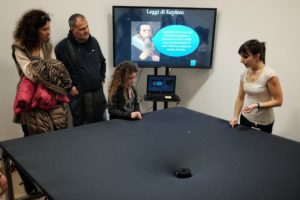 The year 2016 has brought one of the most awaited and important discoveries of modern physics of all times: the first observation of gravitational waves. This event, confirming once again the Einstein’s theory of General Relativity, has given rise to a renewed interest of the general public toward the fascinating topic of gravity. It is in this spirit that the EPS Young Mind section of Rome has organized a whole new project called “Let’s make room for science!”, regarding the three topics of gravity, light and energy. The project, partially founded by 2017 Activity Grant, consisted in creating at the Physics Department of the University of Roma Tre three rooms of exhibits and experiments dedicated to each topic.
The year 2016 has brought one of the most awaited and important discoveries of modern physics of all times: the first observation of gravitational waves. This event, confirming once again the Einstein’s theory of General Relativity, has given rise to a renewed interest of the general public toward the fascinating topic of gravity. It is in this spirit that the EPS Young Mind section of Rome has organized a whole new project called “Let’s make room for science!”, regarding the three topics of gravity, light and energy. The project, partially founded by 2017 Activity Grant, consisted in creating at the Physics Department of the University of Roma Tre three rooms of exhibits and experiments dedicated to each topic.
Regarding gravity, we used a trampoline to simulate the curvature of space-time induced by different masses. Balls of different density and weight allowed the public to reproduce the gravitational force together with the keplerian orbits of the planets around the Sun. The effect of the strong gravitational field of a black hole (the heaviest ball) could also bend the light, reproducing the effect of gravitational lensing. A ripple in the space-time gave an idea of the gravitational waves.
Light and energy were instead treated together with the electromagnetic spectrum. A thermal imager allowed the public to have a first-hand experience of the concept of wavelenght and temperature, but also of the transformation of energy. In this sense, the human body is a perfect laboratory: the sensory organs, for example, are warmer than the hair! The thermal imager, moreover, could reveal the thermal footprint we leave on any surface. The visible light has beeen instead treated through simple but eye-opening experiments with colors (for examples, with prisms). The high energy part of the spectrum (like X rays) has been illustrated by the means of detailed panels. Experiments with currents and circuits concluded the guided tour about electromagnetism.
The “Let’s make room for science” project had more than 600 partecipants between primary and secondary school students and University students. Moreover, the exhibit area has been dedicated to the general public during openening events at University of Roma Tre, like “Eyes On Jupiter” 2017 (http://orientamento.matfis.uniroma3.it/occhisugiove.php).
